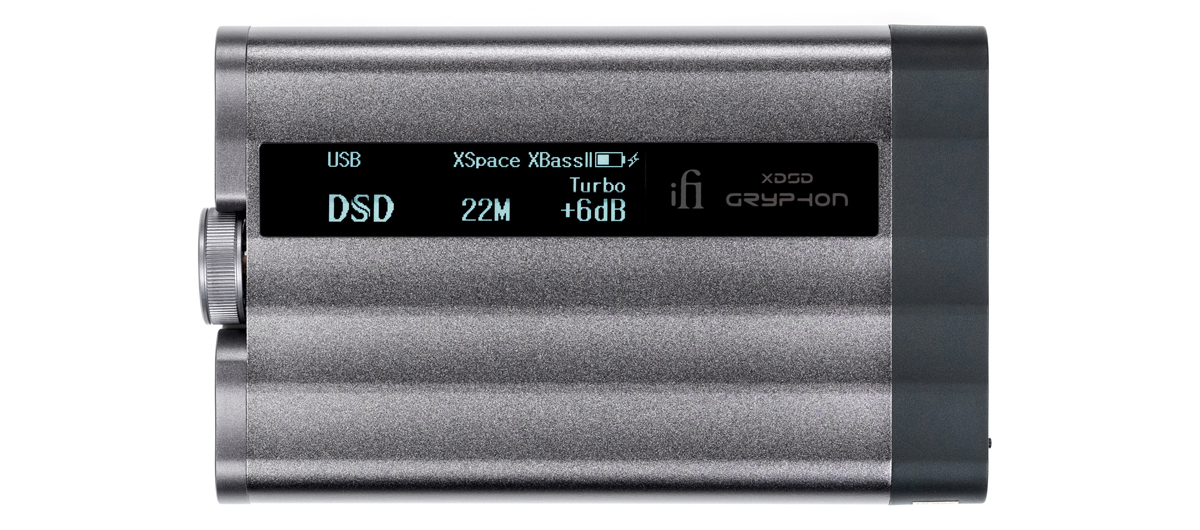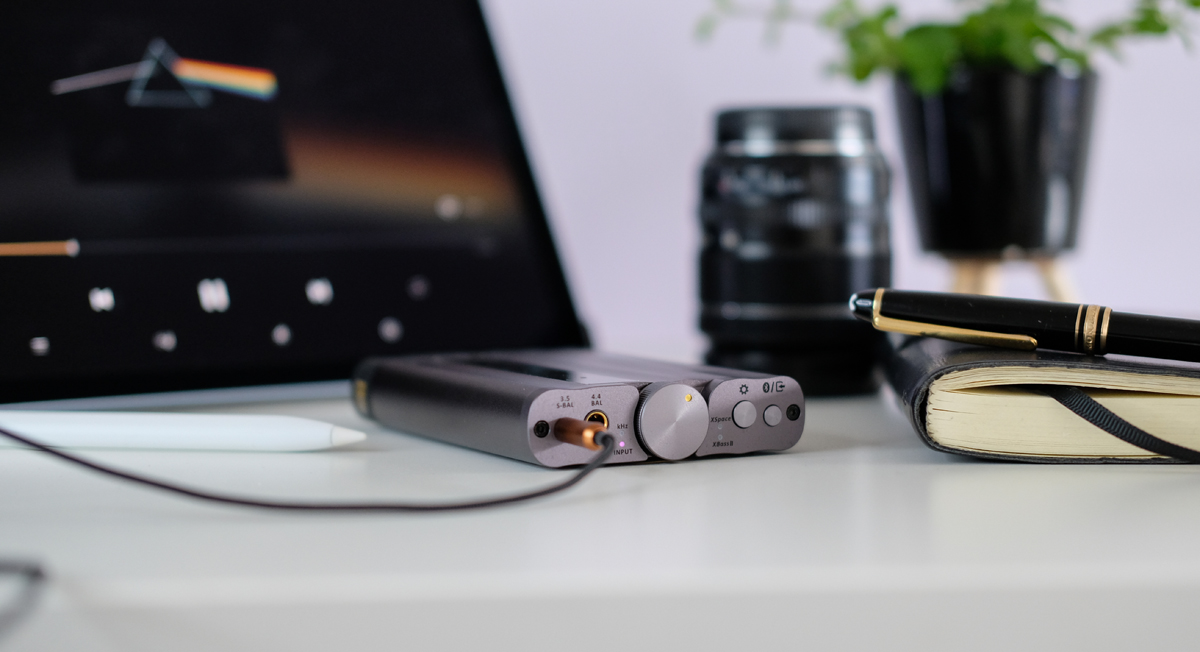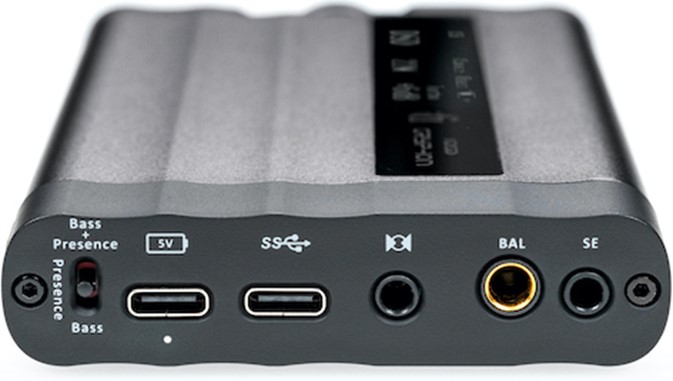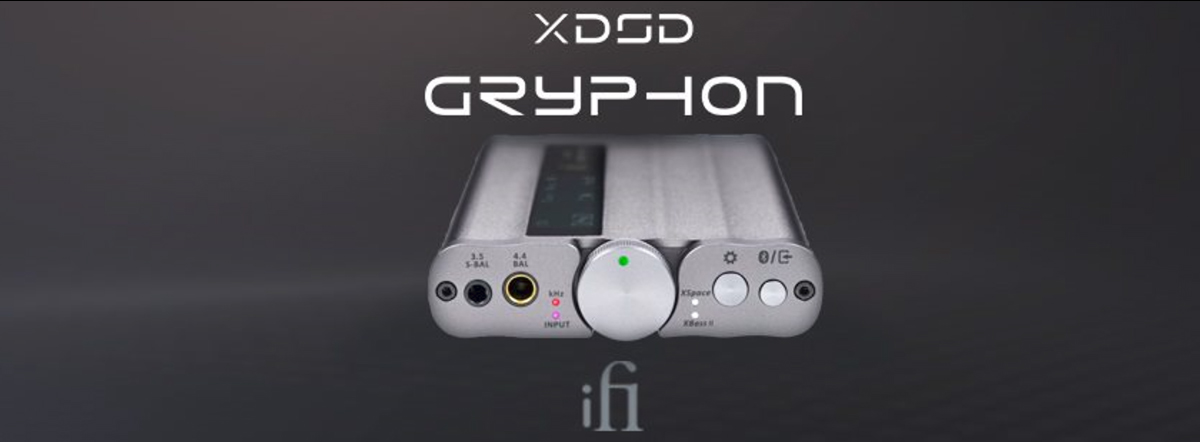Delivering remarkable versatility, state-of-the art technology, and class-leading sound quality with digital and analogue sources, iFi’s latest DAC/headphone amp is a portable marvel.
Southport, England – Launched in 2018, the xDSD is among the most popular portable DAC/headphone amps in iFi’s range – a feature-packed model that has earned a stellar reputation and a plethora of awards thanks to its supremely judged blend of convenience, versatility and performance.
Soon after its launch, the xDSD was joined by the xCAN to complete iFi’s mid-level ‘x-series’ of portable devices. Housed in the same distinctive contoured case with ‘dark titanium’ finish, the xDSD and xCAN perform differing functions – the former is a portable DAC/headphone amp for digital sources, with USB, S/PDIF and Bluetooth connectivity; the latter is a headphone amp with purely analogue inputs, plus the added convenience of Bluetooth reception for smartphones and so on. The xCAN also includes a balanced output stage – the smallest iFi amp to do so at the time of its launch.
This autumn, iFi launches its next-generation x-series device, the xDSD Gryphon – iFi’s most ambitious portable DAC/amp yet. It replaces not only the xDSD but also the xCAN, combining the functionality of both with redesigned circuitry that elevates performance to another level. In the world of portable DACs, headphone amps and ‘head-fi’ in general, the xDSD Gryphon is destined to become a legend.
One DAC/amp to rule them all
Retaining the contoured design of its antecedents, the xDSD Gryphon is clearly an x-series device. Although a little larger, measuring 123x75x19mm, it remains sufficiently compact to stow away in a small bag. (Those who want a more eminently pocketable go-anywhere DAC/headphone amp will find iFi’s recently launched GO blu and hip-dac 2 fit the bill.) At 215g, it is not an overly hefty device thanks to its lightweight yet robust alloy enclosure, and its gunmetal grey finish is less prone to fingerprints than the glossy dark titanium of the original xDSD and xCAN. The extra space provided by the xDSD Gryphon’s larger chassis is fully utilised by the entirely re-engineered tech within, harnessing iFi’s latest technical developments to deliver extreme versatility and performance in a compact, portable form.
Key to the xDSD Gryphon’s flexibility is the sheer breadth of equipment to which it can be connected. Digital and analogue cable inputs are provided – the former in USB and S/PDIF flavours, and the latter via balanced 4.4mm Pentaconn and single-ended 3.5mm sockets. High-definition Bluetooth reception is also provided, enabling smartphones, tablets and more to connect wirelessly with blissful simplicity and optimal sound quality.
This flexibility makes the xDSD Gryphon the ultimate ‘swiss army knife’ of the portable DAC/amp scene, delivering fabulous sound across a host of possible applications – a headphone amp to use with digital and analogue sources; a pure DAC or DAC/preamp to use with an amp and speakers; the heart of a home-based audio system; or a mobile music lover’s dream. The xDSD Gryphon is the high-end audio system you can take with you wherever you go.

Built into the top surface is an OLED display strip, showing a range of useful information including input selection, volume level, battery level, digital audio format and sample rate, along with various other settings. This combines with crisply engineered controls and front-panel LED lighting to ensure the xDSD Gryphon is a pleasure to use, despite the complexity inherent in such a versatile device.
Ultra-resolution digital engine
The xDSD Gryphon’s ‘digital engine’ is based around a Burr-Brown DAC chipset that iFi uses extensively, selected for its natural-sounding ‘musicality’ and True Native architecture. iFi’s experience with this IC means it knows how to make the most of it; but whilst intrinsic to the resulting sound, the creation of an exemplary DAC stage involves much more than the selection of a particular DAC chip.
One such critical component is the XMOS chip that processes the audio data received via the USB and S/PDIF digital inputs. The xDSD Gryphon uses a low-latency, 16-core XMOS microcontroller delivering enhanced processing power; iFi’s in-house digital development team has programmed the XMOS firmware to optimise sound quality and ensure a perfect partnership with the Burr-Brown DAC. Extensive jitter-eradication technologies are also applied to the digital stage, including the latest generation of iFi’s GMT (Global Master Timing) femto-precision clock and intelligent memory buffer.
Every music format at the highest quality
Hi-res audio support is state-of-the-art, handling PCM data to 32-bit/768kHz, all levels of DSD to DSD512, and single- and double-speed DXD. Thanks to the Burr-Brown DAC chip’s four-channel True Native design, PCM and DSD take separate pathways – this enables DSD, as well as PCM, to remain ‘bit-perfect’ in its native form right through to analogue conversion.

MQA – the hi-res streaming codec, as used by Tidal’s ‘Masters’ tier – is also supported through the USB and S/PDIF inputs, with full decoding of MQA files up to 384kHz. This means that the full ‘three unfold’ decoding process is performed internally, as opposed to only the final unfold in the manner of an MQA ‘renderer’. Globally, MQA has become an important consideration for any comprehensively equipped DAC; for Tidal Masters subscribers, the xDSD Gryphon is a great way to make the most of the superior sound of which this streaming service is capable.
Bluetooth done better
While Bluetooth’s convenience and wide device compatibility is well recognised, many people don’t realise how good Bluetooth audio can sound because they’ve only experienced it at base-level quality via rudimentary SoC (System on Chip) implementations. iFi has gone to great lengths to ensure its Bluetooth technology is state-of-the-art, earning it a class-leading reputation.
Making full use of Qualcomm’s latest four-core QCC5100 Bluetooth processing chip, every current high-definition Bluetooth audio format is supported, including aptX Adaptive and aptX HD, LDAC and HWA/LHDC. Other codecs covered include regular aptX and aptX Low Latency, AAC and SBC (the ‘plain vanilla’ Bluetooth codec). This means that every possible source device is handled at the highest audio resolution its Bluetooth specification allows.
The xDSD Gryphon is Bluetooth v5.1-compliant, ensuring the best possible range, stability and performance. Up to seven paired Bluetooth source devices can be stored in memory, making it easy to switch from one device to another.
PureWave – fully balanced circuit design for the purest sound
The digital stage is only half the story in any DAC/headphone amp; when it comes to the crucial analogue circuitry, many such devices fall short. Balanced, differential analogue circuit design has long been championed for its ability to reduce noise and crosstalk within the signal path by fully separating the left and right channels. However, this is more complex and costly than single-ended circuitry, and so has traditionally remained the preserve of high-end hi-fi components.
iFi has gradually introduced fully balanced circuit design across its range – first in the flagship Pro Series components, then in the entry-level ZEN Series devices – with varying levels of sophistication. PureWave is the name iFi has given to the advanced, symmetrical dual-mono circuit topologies found in its latest premium-level devices, such as the NEO and Diablo DAC/amps. The name refers to the sonic purity these designs achieve, thanks to exceptional linearity and infinitesimally low levels of noise and distortion; the xDSD Gryphon is the smallest and most affordable device to feature PureWave design.

Get connected
High-quality components are used throughout, including custom ultra-low-distortion op-amps, multilayer ceramic TDK C0G capacitors, MELF thin-film resistors and inductors from Murata and Taiyo Yuden. These are more costly than common equivalents, but class-leading qualities such as low ESR (Equivalent Series Resistance), high linearity and low noise pay great dividends in terms of sound quality.
The headphone amp stage maintains an engaging balance between sonic power and poise, no matter what it is tasked to drive – from high-sensitivity in-ear monitors to current-hungry planar headphones – with a continuous power output of more than 1000mW into a 32-ohm load available through the balanced headphone socket.
OptimaLoop – negative feedback that is purely positive
‘Negative feedback’ is often used in amplifier circuits to compare the output signal with the input signal and correct errors, in order to control gain and reduce distortion. This has a positive effect on sound quality, at least on paper. But commonly applied, one-size-fits-all ‘global negative feedback’ can create problems while it solves others – corruption of the error signal, phase shifts and group delay can all have a negative impact on sound.
Recognising that different parts of a circuit benefit from specifically optimised feedback loops, iFi has developed a negative feedback system that is much more accurate than the usual approach. This incorporates multiple feedback paths instead of one global loop, each path optimised for a particular function and working synergistically with the others to deliver optimal overall performance. iFi calls this new configuration OptimaLoop.
CyberSync volume control – superior sound and a better user experience
iFi has long championed high-quality analogue volume controls over digital volume adjustment, from a sound quality perspective. The xDSD Gryphon features a new iFi innovation called CyberSync, a redesign of the CyberDrive volume control featured in the original xDSD. CyberSync is a software-driven volume control that operates in the analogue domain – this is not a new concept, but the way it synchronises with any digital source to which the xDSD Gryphon is connected is distinctly different.

With most DACs, the volume control on the source device acts independently of the volume control on the DAC, which may lead to a frustrating user experience and adversely affect sound quality – it may be necessary to set the source device’s digital volume to maximum and adjust only the DAC’s volume control, so as not to lose resolution. In other cases, the source’s software-based volume control may override the DAC’s control; a slicker user experience perhaps, but not ideal for sound quality.
Uniquely, iFi’s CyberSync volume control provides perfect volume synchronisation between the source and the DAC. It detects which operating system (OS) the DAC is connected to – iOS, Android, Windows, Mac OS or Linux – and instructs the source’s OS to bypass its software volume control. Whether volume is adjusted using the xDSD Gryphon’s rotary control or on the source device, CyberSync ensures the change is performed purely by the Gryphon’s superior analogue control chip, while also displaying the adjustment on the source device’s screen. Volume curves differ between operating systems and apps, but CyberSync ensures perfect synchronisation between the source device and the DAC every time.
Kill the noise
Every element of the xDSD Gryphon’s electronic design has been painstakingly considered to prevent distortion and raise the signal-to-noise ratio to class-leading levels. Its low-noise, high-bandwidth power supply circuitry sports linear regulation and delivers excellent PSRR (Power Supply Rejection Ratio) performance. The dimmable OLED display’s SilentLine design ensures there is no electrical noise to interfere with the audio signal. Even the way the xDSD Gryphon switches between settings has been engineered to ensure sonic transparency – FET-based switching is handled by a microcontroller, which only ‘wakes up’ when the user changes a setting, thus eradicating any sonically deleterious interference. To the ear, all this painstaking attention to detail translates as more clarity and texture, and a more dynamic and engaging performance – you hear more of the music, just as the artist intended.
Sonic tailoring to suit you
With differing digital and analogue sources, contrasting headphone/earphone types, multiple music styles and variable recording quality, not to mention personal sonic preferences, the ‘one size fits all’ approach of many devices may be found wanting in one area or another. iFi’s expertly engineered sonic tailoring options ensure the user can calibrate the xDSD Gryphon’s sound to suit their specific preferences, delivering more flexibility to get the sound just right.

With digital sources, users can choose between three bespoke digital filters via the onscreen menu: Bit-Perfect, Standard and GTO (Gibbs Transient Optimised), each having a fine-tuning effect on sound.
Further sonic tuning is provided by iFi’s proprietary analogue processing. Familiar to users of other iFi DAC/amps is XBass – a sophisticated form of ‘bass boost’ that enhances low frequencies without muddying the midrange, useful with earphones and open-back headphones that may lack deep bass. Like the xCAN before it, the xDSD Gryphon sports an expanded version called XBass II, offering three separate headphone EQ options: ‘Bass’ (which targets low frequencies), ‘Presence’ (which focuses on the upper midrange) and ‘Bass + Presence’ (which implements both together).
XSpace is another user-selectable mode, designed to compensate for the ‘in-head localisation’ effect that can occur when using headphones to listen to music that was mixed using a pair of speakers, effectively widening the headphone soundstage to deliver a more spacious and speaker-like experience. Both XBass II and XSpace operate entirely in the analogue domain, rather than messing with the digital signal via DSP, and may be switched in or out of the signal path.
A further switch on the base of the xDSD Gryphon enables IEMatch, another proprietary iFi circuit that attenuates the headphone output to better suit high-sensitivity headphones and, in particular, in-ear monitors, removing potential background noise and increasing the useable volume range.
Well connected
Clever configuration enables the sheer variety of devices that can be connected to the xDSD Gryphon whilst maintaining its compact form. At the rear, two USB–C ports are provided – one input for digital audio, handled asynchronously, and the other for charging, thus keeping the audio and power lines separate for reasons both practical and sonic. Next to these lies the S/PDIF digital input, which allows both optical and electrical (3.5mm) connections.
3.5mm and 4.4mm Pentaconn analogue sockets are also supplied at the back, for single-ended and balanced connections respectively. These double as both inputs and outputs – inputs when the xDSD Gryphon is being used as an analogue headphone amp; outputs to enable its use as a DAC/preamp in a home audio system, with fixed and variable options to connect to an amp and speakers.

At the front, a pair of headphone outputs are provided – a 3.5mm socket for headphones with a single-ended cable/connector, and a 4.4mm Pentaconn output enabling headphones equipped with balanced connectivity to take full advantage of the xDSD Gryphon’s balanced amp design. The 3.5mm output benefits from iFi’s S-Balanced circuitry, cutting crosstalk and related distortion in half when used with regular, single-ended headphone connections.
The iFi xDSD Gryphon is available from mid-November at an RRP of £599, €599 incl. VAT and US$599 ex tax.















Want to join discussion?
Feel free to contribute!